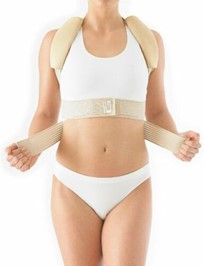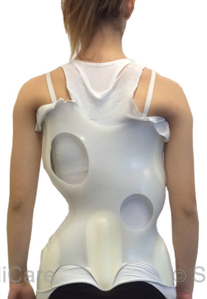At the UK Scoliosis clinic, we specialise in Scoliosis Bracing – Scoliosis Bracing is a non-surgical treatment for scoliosis, which involves the detailed design and manufacture of a specialised, wearable brace which, over time, gently opposes the scoliotic curve in the spine, and works to guide it back towards a normal alignment.
Once upon a time (not too long ago), it was thought that scoliosis could not be stopped – that is to say, it was accepted that the curve would just continue to develop until, eventually, surgery was required to correct the deformity. Sadly, this approach is still recommended by some practitioners – who do not seem to be aware of the preventative and non-surgical corrective options available today.
The results achievable through modern bracing are however, impressive – to sample just a few studies, recent findings show that specialised scoliosis bracing when prescribed for high-risk patients, has been shown to prevent the need for surgery in most cases[1], that, overall, bracing is an effective treatment method for AIS cases, characterized by positive long-term outcomes[2] and even that conservative treatment with a brace is highly effective in treating juvenile idiopathic scoliosis, with most patients reaching a complete curve correction[3]
What’s more, part-time bracing in adults significantly reduces progression of curvatures and improves the quality of life[4], and results suggest that bracing can even be “boosted” through complementary approaches – for example, specialised scoliosis physiotherapy (SEAS), when used in conjunction with bracing, has been shown to improve overall results[5]
There are many reasons to consider bracing as your primary treatment approach if you’re a scoliosis sufferer – however, in order to reap these benefits, it’s vital that you use a specialized, customized scoliosis brace.
This is not a scoliosis brace!
It cannot be stated clearly enough that the above studies all relate to medical-grade TSLO over corrective braces – that is to say, specially designed braces that are customized for the patient and their exact spinal condition. What’s more, these are braces that are fitted, designed, monitored and adjusted by Scoliosis professionals at every stage of the process.
As you may guess, this means braces are not cheap – even the most basic in this category cost over £1000 per brace – this is still far cheaper than surgery and compares favourably with a course of exercise-based treatment – but it’s certainly not an inexpensive item.
It’s probably for this reason that every more products which market themselves as a “scoliosis brace” are appearing on Amazon, eBay and our other favourite shopping sites. It’s critical to realise that these offerings are not even close to the type of brace required for the results discussed above – and in some case, they may cause more harm than good.
These so-called “braces” are (see example right) are very often just posture supports, which may have some marginal benefit for those with a normal spine, but could, in fact, worsen a scoliosis case.
THIS is a scoliosis brace
A genuine scoliosis brace (see ScoliBrace right) is of rigid construction, which while still ergonomic, is able to gently apply pressure to the spine, in opposition to the curve. This means that gentle pressure is exerted in the direction the spine needs to correct, and only in this direction. This is the fundamental mechanism of a scoliosis brace- hence it should be obvious that a fabric-based “support” possesses none of the qualities required for scoliosis correction.
It is not the purpose of this article to single out any individual product, nor are we saying that “soft” supports have no use in spinal care – quite the opposite, however, if you are using a “Scoliosis brace” which you have not obtained through a specialist clinic, we would strongly advise you to discontinue use and seek a professional consultation.
[1] Weinstein et al DOI: 10.1056/NEJMoa1307337
[2] Aulissa et al, https://doi.org/10.1186/s13013-017-0142-y
[3] Aulisa et al, DOI: 10.1186/1748-7161-9-3
[4] Palazzo et al, DOI: 10.1016/j.apmr.2016.05.019
[5] Negrini et al, DOI:10.1186/1471-2474-15-263


